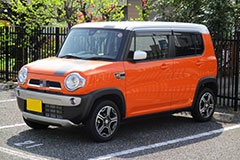Why do Japanese Love Boxy Cars? - Vol.374
If you've ever been to Japan, or just by looking at movies or TV shows from Japan, you might have noticed that their cars tend to be smaller, and boxier in their appearance. This is especially noticeable if you come from North America, where large, heavy, gas-guzzling cars are common. Well, there are several reasons why Japanese cars are boxier, and it's not necessarily associated with aesthetics.

Space
As you probably already know, space is at a premium in Japan. It's one of the countries with the highest population densities in the world, so as a consequence, the cities are incredibly crowded. That doesn't leave much space for the cars to move around, so they need to be smaller. This goes for the width of the street, but also the size of an average parking space, which is smaller than it would be in America. Driving a big SUV is simply not physically possible in many situations in Japan.
So, once you've accepted that a small car is a norm, you need to make sure that this small car will feel as big as possible. Namely, if you have a small car, and you can't make it bigger on the outside, why not make it bigger on the inside? A box shape is great for allowing lots of room inside, while still maintaining compact size on the outside. No wonder boxy cars caught up in Japan, as these proportions make for a very comfortable ride without feeling claustrophobic.
Japanese car manufacturers, in general, offer a larger number of boxier vehicles compared to their lineup abroad. They are typically not concerned with aerodynamic, as the speed limits in Japan are quite restrictive. Even on highways, the limit might not exceed 60 miles per hour (100 kilometers per hour), which is pretty slow compared to North America and Europe. And not to mention countries like Germany, with its fantastic Autobahn system that doesn't have any restriction on certain parts of the highway system.
Kei Cars
Japan's love of boxy cars goes back to the period following the Second World War. It was a tough time for the defeated Japan, as people didn't have enough money, especially for such a big purchase as the car purchase. In an effort to make it easier for their citizens to buy cars, and help the automotive industry, the Japanese government created the "Kei Car Standards", outlining a brand new class of small, inexpensive cars that would be affordable to mass market consumers. The "kei" in Kei Car stands for "kei-jidosha", or light automobile. And these were indeed very light vehicles. Back in 1949, a kei car could have an engine of no more than 150 cubic centimeters, which sounds almost unbelievable compared to modern cars. And it wasn't just the size of the engine that was limited. The car itself was limited to a length of 2.8 meters and a max width of 1 meter.
Over time, the restrictions were gradually lifted, so in 1950, the maximum size of the engine for a kei car was 300 cc, which in the following year was again lifted to 360. By 1990, kei cars could have a length of up to 3.4 meters, with a width of 1.48 meters, powered by an engine no bigger than 660 cc. The maximum power restriction for a kei car is 63 horsepower.
There are other practical benefits to owning a kei car, which makes them a popular choice. Namely, the taxes will be lower, and the insurance will be cheaper. No wonder they are so popular in Japan!